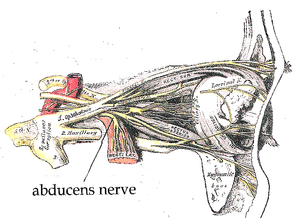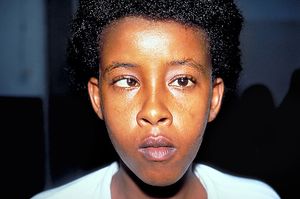Abducens Nerve: Difference between revisions
No edit summary |
No edit summary |
||
| Line 28: | Line 28: | ||
Damage to the abducens nerve can be caused by anything that compresses or stretches the nerve, such as tumors, aneurysms, fractures, or increased intracranial pressure (ICP).<ref name=":0" /> | Damage to the abducens nerve can be caused by anything that compresses or stretches the nerve, such as tumors, aneurysms, fractures, or increased intracranial pressure (ICP).<ref name=":0" /> | ||
[[File:Diplopia.jpg|center|thumb]]{{ | [[File:Diplopia.jpg|center|thumb]] <div class="pp-no-course-suggestions pp-no-article-suggestions"></div> | ||
== Summary == | |||
Description: image of a vertebra | |||
Source: Modified Illustration from Anatomy & Physiology, Connexions Web site. http://cnx.org/content/col11496/1.6/ | |||
== Licensing == | |||
{{Template:Cc-by-sa-3.0}} | |||
Revision as of 15:26, 20 November 2020
This article or area is currently under construction and may only be partially complete. Please come back soon to see the finished work! (20/11/2020)
Original Editor - Innocent Abugu
Top Contributors - Innocent Abugu, Joseph Ayotunde Aderonmu, Kim Jackson and Wendy Snyders
Description[edit | edit source]
The abducens nerve is the sixth cranial nerve (CN VI). It is one of the nerves responsible for the extraocular motor functions of the eye, along with the oculomotor nerve (CN III) and the trochlear nerve (CN IV).[1] It has a purely somatic motor function. It innervates the lateral rectus muscle an extraocular muscle.
Structure[edit | edit source]
Of all the cranial nerves, the abducens nerve has the longest intracranial course.[1] The abducens nerve emerges from the brainstem at the pontomedullary junction to enter the subarachnoid space, coursing upward between the pons and clivus to enter the Dorello canal. At the petrous apex, it angulates to enter the cavernous sinus and travels in close proximity to the internal carotid artery. The abducens nerve then proceeds through the superior orbital fissure and innervates the lateral rectus muscle.[2]
Function[edit | edit source]
The abducens nerve is a purely somatic motor nerve, It has no sensory function.
Motor[edit | edit source]
Its main function is to carry general somatic efferent nerve axons to innervate the lateral rectus muscle which then abducts the eye on the ipsilateral side.[1] The lateral rectus muscle is one of the extraocular muscles of the eye. It originates in the bottom of the orbital cavity in the surrounding area of the optic canal, specifically in the lateral part of the common tendinous ring; the annulus of Zinn.[4]
The abducens nerve is also secondarily involve in innervation of the contralateral rectus muscle by way of the longitudinal fasciculus so that both eyes move laterally in a coordinated manner.[1]
Clinical relevance[edit | edit source]
Compromise of the abducens nerve results in the inability to abduct the ipsilateral eye and partial decrease in the ability to adduct the contralateral eye.[1] Patients usually present with binocular horizontal diplopia (double vision producing a side-by-side image with both eyes open), worse in the distance, an esotropia in primary gaze. Patients also may present with a head-turn to maintain binocularity and binocular fusion an to minimize diplopia.[2]
Damage to the abducens nerve can be caused by anything that compresses or stretches the nerve, such as tumors, aneurysms, fractures, or increased intracranial pressure (ICP).[1]
Summary[edit | edit source]
Description: image of a vertebra Source: Modified Illustration from Anatomy & Physiology, Connexions Web site. http://cnx.org/content/col11496/1.6/
Licensing[edit | edit source]
This file is licensed under the Creative Commons Attribution-Share Alike 3.0 Unported license.
You are free:
- to share
- to copy, distribute and transmit the work to remix
- to adapt the work
Under the following conditions:
- attribution – You must attribute the work in the manner specified by the author or licensor (but not in any way that suggests that they endorse you or your use of the work).
- share alike – If you alter, transform, or build upon this work, you may distribute the resulting work only under the same or similar license to this one.
Assessment[edit | edit source]
The abducens nerve is examined in conjunction with the oculomotor and trochlear nerves by testing the movements of the eye. The patient is asked to follow a point with their eyes (commonly the tip of a pen) without moving their head. The target is moved in an ‘H-shape’ and the patient is asked to report any blurring of vision or diplopia (double vision).[5]
Treatment[edit | edit source]
Treatment of abducens nerve palsy include eye muscle exercises, prism therapy, injection of botulinium toxin, strabismus surgery.
Resources[edit | edit source]
References[edit | edit source]
- ↑ 1.0 1.1 1.2 1.3 1.4 1.5 Nguyen V, Reddy V, Varacallo M. Neuroanatomy, cranial nerve 6 (abducens). StatPearls [Internet]. 2020 Aug 11.
- ↑ 2.0 2.1 Hajee ME, MP E. Abducens nerve palsy. E_Medicine.
- ↑ Abducens Nerve - Anatomy Tutorial. Available from: https://youtu.be/qbrv5EcQDic [last accessed 20/11/2020]
- ↑ Cabrera AF, Suárez-Quintanilla J. Anatomy, head and neck, eye lateral rectus muscle. StatPearls [Internet]. 2020 Aug 10.
- ↑ Radhakrishnan A. The Abducens Nerve (CN VI). Available from:https://teachmeanatomy.info/head/cranial-nerves/abducens-nerve/.








